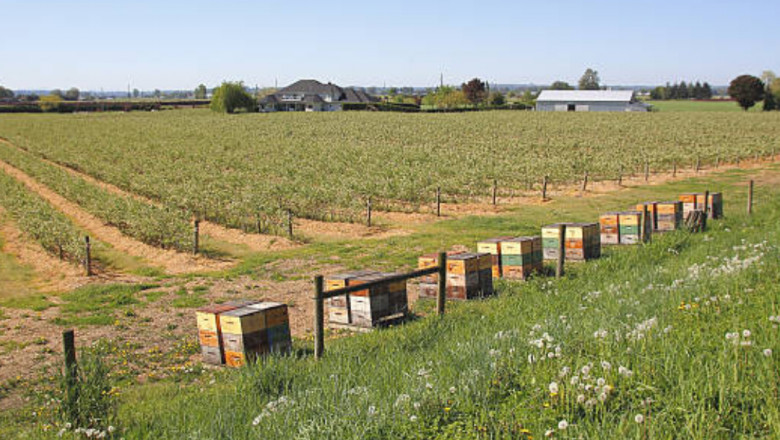views
Owning a large yard comes with plenty of benefits—room for gardens, recreation, and outdoor activities. However, it also presents a unique set of challenges, especially when it comes to managing bee activity. While bees are essential for pollination and environmental health, unmanaged populations can create hazards for pets, children, and individuals with allergies. A proactive bee management plan allows you to maintain a healthy balance between fostering pollinators and protecting your space. This article will walk you through how to create an effective, long-term strategy to manage bee presence in larger outdoor areas without compromising nature’s balance.
Why a Bee Management Plan Is Essential for Large Yards
In larger properties, bees have more space to establish hives, forage, and interact with plant life. Without a structured bee management plan, you might unknowingly provide ideal conditions for nesting or swarming. Flowering trees, overgrown shrubs, and open compost bins are often overlooked contributors to increased bee activity. Beyond discomfort, this can pose risks if nests form near walkways, patios, or children’s play zones. Having a thoughtful, sustainable strategy ensures that you can prevent unwanted nesting, maintain pollination-friendly gardens, and reduce potential safety concerns—all while respecting the critical role bees play in the ecosystem.
Step One: Assess Your Yard and Identify Attractants
The first step in any effective bee management plan is evaluating your yard for attractants and problem areas. Start by identifying flowering plants, fruit trees, compost piles, and any sources of standing water. Bees are naturally drawn to bright blooms, sweet smells, and water sources, so pinpointing these helps you understand where they are most active. Also, inspect your property for cavities or crevices where bees could build hives, such as unused equipment, under eaves, or in hollow trees. Once you’ve gathered this information, you’ll be in a better position to take preventative and corrective action.
When to Call a Professional for Help
While many homeowners prefer to manage bee activity independently, large yards can sometimes attract colonies that are difficult to control. If you notice an unusually high level of bee traffic or suspect the presence of a hive, it’s time to consult a professional. Engaging a reputable bee removal service in Nashville, TN, ensures that bees are removed safely and humanely. These experts can inspect the property, locate hidden nests, and provide long-term prevention advice. Working with professionals as part of your bee management plan allows you to address infestations while staying aligned with ecological best practices.
Managing Flowering Plants and Landscaping Choices
Your landscaping strategy plays a major role in either encouraging or deterring bee activity. A well-structured bee management plan includes selecting plant species that either reduce excessive attraction or concentrate bee activity in less-trafficked areas. For instance, placing pollinator-friendly flowers at the far ends of your property will keep bees away from seating areas and walkways. Avoid planting high-nectar plants near entrances or patios. Additionally, routine maintenance such as pruning overgrowth and removing weeds will limit nesting opportunities and reduce hiding spots for swarms or colonies.
Incorporating Bee Deterrents and Natural Solutions
Once your yard is properly evaluated and landscaped, consider using natural deterrents as part of your bee management plan. Bees dislike scents like peppermint, eucalyptus, and clove, which can be introduced through sprays, candles, or essential oil diffusers in strategic locations. Hanging fabric softener sheets or using natural citrus sprays around entry points and patios can also keep bees at bay. These methods offer an eco-friendly alternative to chemical repellents, keeping your yard safe for people, pets, and other beneficial insects. Combined with other strategies, they serve as a practical layer of protection.
Creating Safe Zones and Pollinator Areas
Managing bees doesn’t mean eliminating them. A balanced bee management plan includes designated pollinator zones where bees can thrive safely. Set aside a remote part of your property to plant bee-friendly flowers and native grasses. Add bee hotels or small water sources to encourage healthy foraging and nesting, away from high-traffic areas. This method promotes biodiversity and supports bee populations while keeping your main yard activities undisturbed. By directing bee activity where it’s least disruptive, you create a win-win situation for both people and pollinators.
Long-Term Maintenance and Seasonal Adjustments
A strong bee management plan is not a one-time fix but an ongoing commitment. With changing seasons, different challenges arise—spring may bring swarming, while late summer often increases bee foraging. Regularly inspect your yard for signs of activity, update deterrents, and adjust plant placement if needed. Keep an annual schedule for maintenance tasks such as trimming trees, sealing potential nesting areas, and refreshing natural repellents. Document any bee issues or hive removals so you can adapt your strategy over time. A dynamic, flexible approach ensures your yard remains safe, enjoyable, and environmentally responsible year-round.
Conclusion
Creating a successful bee management plan for large yards involves a careful balance between control and coexistence. From evaluating your space and adjusting landscaping to using natural deterrents and partnering with professionals when needed, each step contributes to a safer and more harmonious outdoor environment. By being proactive and intentional, you not only reduce the risk of unwanted bee encounters but also contribute positively to the local ecosystem. Large yards are a privilege—and with the right strategy, they can remain beautiful, functional, and bee-friendly spaces.














Comments
0 comment